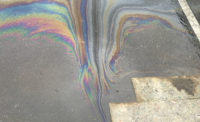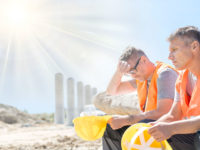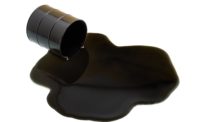Let’s face it — no matter how much we try to avoid them, spills happen. Common spills involve substances such as gasoline, oil, solvents, and cleaning chemicals. While small, in-house spills might be easy to clean up quickly, some fluids can be toxic when ingested or exposed to skin and can be hazardous to the environment. In fact, the Environmental Protection Agency (EPA) says that only a few quarts of oil can severely degrade a small stream. Spill preparedness means inventorying the hazardous substances you have onsite, evaluating the potential for spills, and planning for how you’ll respond to a spill.
A tale of two spills
Tonya works in the auto maintenance bay. On Friday, she is carrying a couple quarts of used oil to the used oil tank when she trips and spills oil all over the floor. There are a few different ways this episode could play out, but let’s look at the worst- and best-case scenarios.
Worst-case scenario (Cue the horror music.): Tonya trips right next to a floor drain. She’s got about two minutes before the oil reaches the drain, which, you guessed it, eventually drains to a ditch that empties into a nearby creek after a rain. Nobody knows what to do, who to call, or how to stop the oil from flowing into the drain. Finally, Tonya decides to find her manager.
Best-case scenario (Cue the inspirational music.): Tonya says some choice words, but quickly looks around and spots the plastic drum clearly labeled “Oil Spill Kit” only a few feet away. Tonya knows to snap the tape holding the cover on the drum and quickly grab gloves, goggles, and sorbent materials. She places a sorbent “sock” between the spilled oil and the floor drain before sprinkling a drying material on the oil and scooping it into a bag designed for that purpose. She labels the bag “Used Oil Materials” along with the date and then radios for Facilities to dispose of the bag properly.
As a safety professional, you may spot ways to prevent the oil spilling in the first place (keeping a tight lid on the portable container, ramping up housekeeping efforts to eliminate trip hazards), but if a spill did occur, we’d all want a worker to know how to respond quickly and appropriately.
Preparing for a spill
OSHA’s Hazard Communication Standard (HazCom) requires you to train employees who have the potential to be exposed to incidental spills to understand the hazards of the chemical substances spilled. (Note that if you work with hazardous waste or expect employees to have to clean up very large spills, OSHA’s HAZWOPER standard may also apply.) You can consult the safety data sheet (SDS) to learn about the proper equipment and training necessary to work with or safely clean up each hazardous chemical. The SDS should also give you a good idea of what needs to be in your spill kit.
While spill kits aren’t mandated, they can be an effective way to meet regulatory requirements to contain, clean up, or dispose of hazardous substances. They can also help you meet secondary containment requirements found in several regulations. Further, spill kits can be a key part of your spill response plan. The number of kits you assemble, where you place them, and how you stock them will depend on the type of the spills you anticipate, the probable location of those spills, the size of the potential spills, and whether a spill could threaten sensitive environmental areas.
Spill kits run the gamut from expensive, commercially made kits to homemade kits cobbled together using materials at hand. All spill kits must be designed to protect employees from the hazards of a spill while at the same time addressing four main areas:
- Spill control. This could be as simple as putting the bung back in a drum.
- Containment. Stop the spill from spreading. In the used oil spill scenario, Tonya contained the spill using a sorbent sock.
- Cleanup. In the simplest terms, cleanup involves removing the spilled substance.
- Disposal. All spilled substances and the materials used to clean them should be placed in appropriate containers, labeled and dated, and evaluated for proper disposal.
Spill kit labels should be easy to read and indicate the type of spills they’re intended to address.
Place kits near where spills are likely and train employees on how to use each item in the kit. Be sure to train employees on situations that call for evacuating rather than trying to handle the spill, such as life-threatening releases, fire or explosions, or releases of extremely toxic chemicals. In addition, emergency notification requirements may apply to certain spills such as releases of toxic chemicals into the air or oil spills that reach water sources. Also train employees on your reporting procedures.
What’s in a spill kit?
For ideas on what should be in a spill kit, consult the SDSs for the chemicals at your workplace. Typical spill kits contain the following:
- Personal protective equipment (PPE): Gloves, boots, overalls, aprons, face shields, masks, goggles, hard hats, and even hazmat suits.
- Control equipment: Duct tape, hammers, wrenches, cutting tools, putty and patching materials, wedges, dowels, plugs, inflatable bags, clamps, ropes, chains, and leak detectors.
- Containment materials: Sand, clay, ash, sawdust, kitty litter, absorbent pillows and socks.
- Cleanup materials: Shovels, brooms, mops, pads, scrub brushes, soap, disinfectants, buckets, towels, etc.
- Disposal materials: Chemical resistant bags, buckets, drums, and waste labels.
- Other considerations: First aid kit; radio, caution signs, and barricade tape; guidebooks; and environmental monitoring equipment such as air quality monitors, meters, and wind detectors.
If you choose to assemble your own kit, pack it so that the most important items will be available first. That means PPE needs to be on top, followed by control equipment, containment materials, disposal materials, and so on. It’s a best practice to inspect spill kits regularly to be sure all the components are clean, working, and ready to go.
Of course, the best scenarios are those where no spills occur in the first place; but if you do have a spill, it’s always better to be prepared for them.



